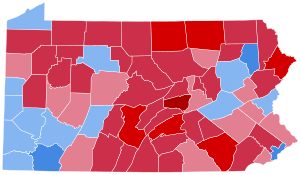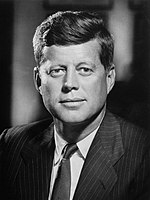
The 1952 United States presidential election was the 42nd quadrennial presidential election and was held on Tuesday, November 4, 1952. Republican Dwight D. Eisenhower won a landslide victory over Illinois Democratic Governor Adlai Stevenson II, becoming the first Republican president in 20 years. This was the first election since 1928 without an incumbent president on the ballot. Eisenhower was re-elected in 1956 in a rematch with Stevenson.

The 1956 United States presidential election was the 43rd quadrennial presidential election. It was held on Tuesday, November 6, 1956. President Dwight D. Eisenhower successfully ran for reelection against Adlai Stevenson II, the former Illinois governor whom he had defeated four years earlier. This election saw the sixth rematch in American presidential history, the last until 2024, and the second where the winner was the same both times. This was the last election before the term limits established by the 22nd Amendment came into effect, Eisenhower being the first President elected twice to the office following the Amendment's ratification.
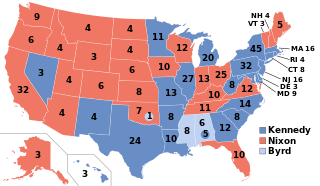
The 1960 United States presidential election was the 44th quadrennial presidential election. It was held on Tuesday, November 8, 1960. In a closely contested election, Democratic Senator John F. Kennedy defeated the incumbent Vice President Richard Nixon, the Republican nominee. This was the first election in which 50 states participated, marking the first participation of Alaska and Hawaii, and the last in which the District of Columbia did not. This made it the only presidential election where the threshold for victory was 269 electoral votes. It was also the first election in which an incumbent president –in this case, Dwight D. Eisenhower– was ineligible to run for a third term because of the term limits established by the 22nd Amendment.

Adlai Ewing Stevenson II was an American politician and diplomat who was the United States Ambassador to the United Nations from 1961 until his death in 1965. He previously served as the 31st governor of Illinois from 1949 to 1953 and was the Democratic nominee for president of the United States in 1952 and 1956, losing both elections to Dwight D. Eisenhower in a landslide. Stevenson was the grandson of Adlai Stevenson I, the 23rd vice president of the United States.

The 1960 Democratic National Convention was held in Los Angeles, California, on July 11–15, 1960. It nominated Senator John F. Kennedy of Massachusetts for president and Senate Majority Leader Lyndon B. Johnson of Texas for vice president.
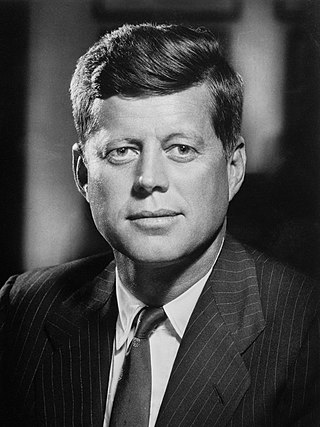
From March 8 to June 7, 1960, voters and members of the Democratic Party elected delegates to the 1960 Democratic National Convention through a series of caucuses, conventions, and primaries, partly for the purpose of nominating a candidate for President of the United States in the 1960 election. The presidential primaries were inconclusive, as several of the leading contenders did not enter them, but U.S. Senator John F. Kennedy of Massachusetts emerged as the strongest candidate and won the nomination over Lyndon B. Johnson at the convention, held from July 11 to 15 at the Los Angeles Memorial Sports Arena.

The 1960 United States presidential election in California took place on November 8, 1960 as part of the 1960 United States presidential election. State voters chose 32 representatives, or electors, to the Electoral College, who voted for president and vice president.

This is the electoral history of Adlai Stevenson II, who served as Governor of Illinois (1949–1953) and 5th United States Ambassador to the United Nations (1961–1965), and was twice the Democratic Party's nominee for President of the United States, losing both the 1952 and 1956 presidential general elections to Republican Dwight D. Eisenhower.
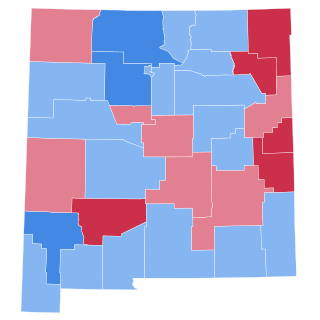
The 1960 United States presidential election in New Mexico took place on November 8, 1960. This was the first year where all 50 current states were part of the 1960 United States presidential election. State voters chose four electors to represent them in the Electoral College, who voted for president and vice president.
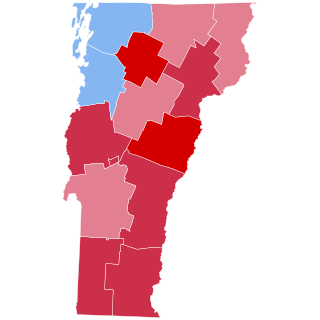
The 1960 United States presidential election in Vermont took place on November 8, 1960, as part of the 1960 United States presidential election which was held throughout all 50 states. Voters chose three representatives, or electors to the Electoral College, who voted for president and vice president.

The 1960 United States presidential election in New Jersey took place on November 8, 1960. All 50 states were part of the 1960 United States presidential election. Voters chose 16 electors to the Electoral College, which selected the president and vice president.

The 1960 United States presidential election in New Hampshire took place on November 8, 1960, as part of the 1960 United States presidential election, which was held throughout all 50 states. Voters chose four representatives, or electors to the Electoral College, who voted for president and vice president.

The 1960 United States presidential election in Texas was held on November 8, 1960, as part of the 1960 United States presidential election. The Democratic Party candidate John F. Kennedy, narrowly won the state of Texas with 50.52 percent of the vote to the Republican candidate Vice President Richard Nixon's 48.52%, a margin of two percent, giving him the state's 24 electoral votes. Despite the presence of U.S. Senator Lyndon B. Johnson on the Democratic ticket, the result made Texas the tenth closest state in the election. Nixon's strong performance in the Dallas–Fort Worth Metroplex, Harris County, the Panhandle, and the Hill Country kept the race close.
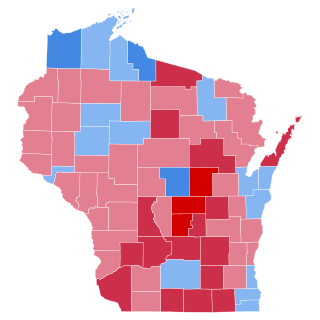
The 1960 United States presidential election in Wisconsin was held on November 8, 1960 as part of the 1960 United States presidential election. State voters chose 12 electors to the Electoral College, who voted for president and vice president. Politics in Wisconsin since the Populist movement had been dominated by the Republican Party. The Democratic Party became uncompetitive away from the Lake Michigan coast as the upper classes, along with the majority of workers who followed them, fled from William Jennings Bryan’s agrarian and free silver sympathies. Although the state did develop a strong Socialist Party to provide opposition to the GOP, Wisconsin developed the direct Republican primary in 1903 and this ultimately created competition between the “League” under Robert M. La Follette, and the conservative “Regular” faction. This ultimately would develop into the Wisconsin Progressive Party in the late 1930s, which was opposed to the conservative German Democrats and to the national Republican Party, and allied with Franklin D. Roosevelt at the federal level.

The 1960 presidential campaign of John F. Kennedy, then junior United States senator from Massachusetts, was formally launched on January 2, 1960, as Senator Kennedy announced his intention to seek the Democratic Party nomination for the presidency of the United States in the 1960 presidential election.

The 1960 United States presidential election in Mississippi took place on November 8, 1960, as part of the 1960 United States presidential election. Voters chose eight representatives, or electors to the Electoral College, who voted for president and vice president. This was the last election in which Mississippi had eight electoral votes: the Great Migration caused the state to lose congressional districts for the third time in four censuses before the next election.

The 1960 United States presidential election in Iowa took place on November 8, 1960, as part of the 1960 United States presidential election. Voters chose ten representatives, or electors, to the Electoral College, who voted for president and vice president.

The 1960 United States presidential election in Oregon took place on November 8, 1960, as part of the 1960 United States presidential election. Voters chose six representatives, or electors, to the Electoral College, who voted for president and vice president.

The 1960 United States presidential election in Illinois took place on November 8, 1960, as part of the 1960 United States presidential election. State voters chose 27 representatives, or electors, to the Electoral College, who voted for president and vice president.

The 1960 United States presidential election in North Carolina took place on November 8, 1960, as part of the 1960 United States presidential election. North Carolina voters chose 14 representatives, or electors, to the Electoral College, who voted for president and vice president.
